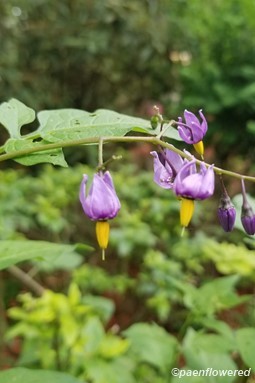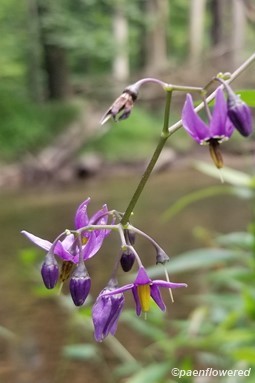Solanum dulcamara
A semi-nvasive vine that colonizes man-disturbed habitats
Solanum dulcamara trailing nightshade
This alien import from Europe, Asia and North Africa has become widespread in North America. The species is considered "potentially invasive" in Connecticut and sale of it is banned. It can grow in a variety of habitats but is most common in moist thickets, clearings and fencerows. It is a member of the same family and genus as the potato and tomato and the flowers show that relationship.
The plant is a weak, semi-woody vine that can grow 2 to 8 feet long. Although it is a climbing plant it lacks tendrils. The ½ inch star-shaped, stalked flowers form in drooping clusters of 3-20. Each has five dark violet petals that bend backwards and a yellow center made from the anthers that look like a beak. An inconspicuous style extends beyond the column of anthers. The plant may bloom from June to September. The major pollinators are bumblebees and halictid bees. They extract pollen by "buzz pollination". There is no nectar reward. After pollination a soft, juicy, berry forms that looks like a miniature tomato, turning from green to red. The alternate leaves are distinctive, arrow-shaped and have two lobes at their base. Each leaf is up to 4 inches long and 2.5 inches wide.
The leaves and fruit of the plant contain the poisonous alkaloid solanine. Although the plant is often called the deadly nightshade, a person can become ill only if large numbers of the berries are consumed. There has not been a death attributed to eating the berries in the United States since 1948. Nevertheless children are sometimes attracted to the red berries and caution should be taken where they might have access to this plant. Some types of birds and small mammals can eat the berries without harm and help distribute the seeds.
In traditional herbal medicine the plant has been used to treat skin diseases, but there is little confirmed medical evidence to support this. In medieval England it was used to counteract "witchcraft".
Habitat & Range
Common in moist open woods, bogs, wet thickets, and waste ground.
Present throughout the state.
Range: Widespread in North America. It seems to be less common in the far South of the United States.
| EMP: | FAC |
|---|---|
| NCNE: | FAC |
Phenology
Flowers May to August.
Identification Tips
Two lobes at the base of the leaf










Comments
Have you spotted this plant in your area? We'd love to hear about your experience! Share your comments or questions about the plant below. Comments are moderated before posting.